This past week has been a bit of a whirlwind. We’ve stayed at drab airport hotels, beautiful luxury resorts and curated lifestyle hotels in the countryside, in Morocco and England. Going from one place to another has made me reflect on how to measure the quality of a hotel.
First comes location, followed by comfort, and after that the aesthetics of the place. Is it in a beautiful setting, is the décor on point? In some of these places, the answer was an obvious yes, which is probably why they’ve also been written about in some of the most influential travel and lifestyle magazines that exist.
But are they nice? That’s a different question.
A recent experience at a hotel in Morocco made me reflect on the value of friendliness. The hotel design checked all the necessary boxes for a place wanting to appear contemporary: vintage 1960s Italian furniture, textile art by local artists, a “library” (without any actual books). The colour scheme was kept neutral, dominated by off-white, beige, and sand. The result is a sense of staged rusticness, an updated version of shabby chic for people too chic to probably appreciate anything remotely shabby. Despite this, the atmosphere seemed off, and when I spoke with the staff (who seemed surprised to be treated as anything else but servants) no one had worked there for more than a few months, even though the hotel had been open for more than a year and a half. For all the money spent on architecture and furniture, on plants and other decorations, not to mention a very Instagrammable pool, there was just no ambience – differently phrased, it had no soul.
A few days later, I had a similar experience in the English countryside, where everything was designed to look rural and relaxed, but really just felt like being an extra in an episode of “Westworld”. The rustic aesthetics just barely concealed an industrial approach to hospitality: 45 minutes before check-out, the receptionist called our room and suggested I leave so the cleaners would have access. My partner was having breakfast but I was told not to wait, and so I emptied the room and went to the reception, where they called a taxi before I even had a chance to let him know that we were leaving.
The two hotels are part of the recent cultural shift from peak lifestyle to peak aesthetics: more attention is now brought to the appearance of things than they experience of them, simply because we now live in a visual culture where everything is either part of a digital mood board or background scenography for a short film on social media, at the expense of human connection. In this way, it’s a stark contrast to a third place we stayed at, Kasbah du Toubkal, where genuine conversations were had over shared dinners with the owners, their friends, and other guests, while the sun set over the surrounding Atlas Mountains. The interiors did in no way resemble what I saw in the latest issue of World of Interiors, but even though I’m now in another continent, I’m still in contact with some of the people I shared meals with in the Moroccan mountains.
On a completely unrelated note: I think this is what annoys me the most with the current AI hysteria, it’s all about what the technology can create, but nothing about what is being lost in the process. Mindless copying of visual references but no soul and no human connections.
While traveling back and forth like this, I’ve been reading Ed Young’s An Immense World. Its starting point is the zoologist Jakob von Uexküll concept Umwelt, which refers to an animal’s perceptual world. Different animals experience the world differently depending on how their senses are developed; they can be in the same physical space and have completely different Umwelten, meaning that they will perceive the space in vastly different ways. Anyone who’s ever lived with a dog can testify to this, it’s apparent that dogs access different kinds of information and see the world through their noses, while humans primarily use their eyesight. A tick, questing for mammal blood, cares about body heat, the touch of hair, and the odour of butyric acid emanates from the skin. These three things constitute its Umwelt. Trees of green, red roses too, skies of blue, and clouds of white (as the song goes) – the tick doesn’t wilfully ignore these colours and how they make the world a more wonderful place, it simply cannot see them and doesn’t know they exist.
The book demonstrates how subjective our experiences are – we rely on the senses we have access to in making sense of the world. Our understanding of the context we live in is thus very limited, or at least deeply subjective, but we rely on them to form what we think are objective decisions. As I write this, our dog is resting by my feet and I wonder how he is experiencing this moment, based on his Umwelt. Dogs like to smell where others have been, exploring the same object several times at different distances. At the back of a dog’s snout is the olfactory epithelium, where smells are first detected. The advanced structure of this is the reason dogs can sniff out bombs, find hidden narcotics in suitcases, know the direction a person is walking in after just having smelled a few footsteps, and finding truffles hidden in the Italian soil.
Light always moves in a straight line, but smells diffuse and seep, flood and swirl. They can travel through darkness and around corners, so even when humans can’t look into a bag, dogs can smell the inside. I find this immensely fascinating, especially as we also recently stayed at the Olinto in the Atlas Mountains with its vast botanical gardens, where the scent of flowers became part of the hotel experience.
When I think back on our days there, what I remember first is the smell of white roses that surrounded every swimming pool, how all the pathways were lined with lavender, and the jasmine-tangled pergola that we sat in during breakfast.
Firs the scents hit me, and then the images.






